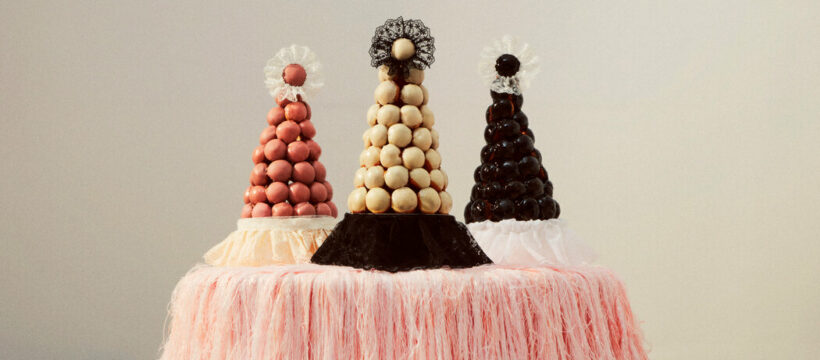Croquembouche, the French pastry popularized in the early 19th century, is suddenly back on the banquet table.
Seeking to evoke “a meeting of wise characters coming from a fantasy world,” the Paris-based baker Andrea Sham created a trio of croquembouche pastries exclusively for T.Credit…Photograph by Florent Tanet. Set design by Nicholas William White
Supported by
Send any friend a story
As a subscriber, you have 10 gift articles to give each month. Anyone can read what you share.
By Ella Riley-Adams
THE CHEF MOST often credited with inventing the croquembouche, the French-born confection that towers haughtily over any table it graces, was, unsurprisingly, an architecture enthusiast. Toward the end of the French Revolution, years before he baked the cake for Napoleon Bonaparte’s (second) wedding, Marie-Antoine Carême began an apprenticeship at a patisserie near the Palais Royal. He’d spend his afternoons in the national library across the street, mesmerized by images of architectural marvels. “He copied in ink — and then created in pastry and marzipan, in sugar paste and spun sugar — the ruined castles and hermitages, temples, pyramids and fountains he had seen in the Bibliothèque,” writes Ian Kelly in his 2003 biography of Carême, “Cooking for Kings.”
Among Carême’s most heroic specialties were his statuesque pastries, known as extraordinaires, some shaped as giant harps or colonnaded fountains. But it was the croquembouche in particular — a conical tower typically rising several feet high and constructed out of cream puffs (a.k.a. choux à la crème) bound together with caramel — that became a staple of French wedding banquets and, eventually, his legacy.
Its name translated as “crunch in the mouth,” the pastry, when made properly, should deliver a gratifying crackle with every bite. Ensuring that crunch — by preparing the dough just so, and serving before the caramel softens — is in itself a feat, says Claire Saffitz, 36, the baker and food writer who included a recipe for croquembouche in her 2020 book, “Dessert Person,” cautioning readers that it’s an arduous undertaking. The outsize ambition required for a croquembouche may be why, along with its undeniable visual appeal, a crop of young pastry chefs are reviving the form. Over the years “it became a way of showing off my baking achievement,” says Saffitz. “People sort of gasp and they’re like, ‘What is that?’”
Last spring, Zélikha Dinga, 33, a Parisian chef who runs the catering company Caro Diario, created a 2 1/2-foot-tall croquembouche after the Danish fashion brand Ganni requested “something spectacular” for a Paris dinner event. Dinga embellished her collection of cream puffs with a scattering of pale yellow and pink snapdragons, accompanying it with stalks of poached rhubarb and a mound of Chantilly cream. “To me, everything about the croquembouche is appealing,” says Dinga, noting its unusual shape, its gleam and “the ceremony of serving it.”
This means that the croquembouche is the ideal dessert for an era in which food is consumed first by the eyes. In December, the nonalcoholic spirits company Ghia held an event at the Los Angeles nightclub Los Candiles for which the main centerpiece was a 200-puff croquembouche pierced with sparklers. That same month at Nine Orchard, a new hotel on Manhattan’s Lower East Side, the French fashion brand Hermès hosted a dinner where the New York-based artist Laila Gohar, 34, presented a savory spin on the croquembouche, replacing the puffs with brussels sprouts, purple potatoes and turnips. But then, at the end of the meal, the sweet version emerged, too — laboriously constructed by Nine Orchard’s executive director of food and beverage, Jason Pfeifer, 38, and doused with a pour of melted bittersweet chocolate. And in March, at the 95th Academy Awards Governors Ball after-party, guests came face to face with miniature chocolate Oscar statuettes perched on a croquembouche, its puffs filled with mango and passion fruit cream.
ANOTHER KEY PART of its allure: The croquembouche provokes childlike wonder, as well as childlike eating habits. It’s sticky, gloriously so. The Paris-based baker Andrea Sham, 36, appreciates the hands-on aspect. “There’s a contact thing with it; everyone’s taking the choux,” she says. “It’s quite messy, but it’s fun.” When Sham was asked to create a croquembouche for a 2022 wedding, she mixed charcoal powder with the caramel to give some of the puffs a patent leather shine, while she turned others white with a thin layer of fondant, then tucked peach-colored chrysanthemums in between orbs.
But though it may inspire messiness, the simplest croquembouche takes precision. For starters, one must perfect the dough for the choux, which is often topped with craquelin, a thin layer of cookielike dough that adds crunch and a buttery flavor. Then comes the assiduously whipped pastry cream that fills the choux. Finally, there’s the caramel that not only glues the choux together but gives it all a pleasing sheen. Some bakers use a conical mold to ensure a perfect shape. Others prefer a more artisanal approach. When Julia Child made croquembouche with Martha Stewart, Child constructed hers “country-style,” as Stewart put it, in more of a pile than a hollow building. Saffitz prefers an organic, coneless construction and, despite the seeming fragility of the form, notes that one of her foot-high croquembouches fared fine on a hundred-block New York City taxi trip.
So why, of Carême’s many intricate extraordinaires, has the croquembouche persisted when the others remain locked in the culinary archives? One theory: It offers satisfaction from beginning (the cook marveling at her own accomplishment) to end. Much of Carême’s elaborate centerpieces, with their hardened dough and excess of spun sugar, were never intended for consumption; they were as flavorful as cardboard and often reused at multiple banquets. By contrast, a tower of choux is meant to be enjoyed within an evening, shortly after the puffs have been piped. Yes, its grandeur can be preserved on Instagram, but the real delight of it is purely present tense.
Set assistant: Lola Faraud
Site Index
Site Information Navigation
Source: Read Full Article

